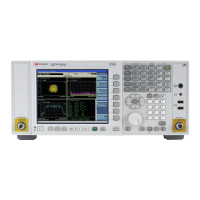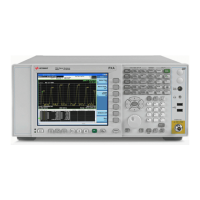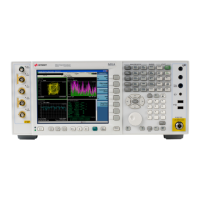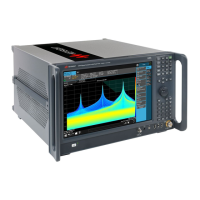142 Chapter 5
Digital IF Troubleshooting
A3 Digital I.F. Troubleshooting
12. The analyzer should read 22.5 MHz at −25 dBm ± 4 dB as shown in Figure 5-2.
Figure 5-2 A3 Digital I.F. Input
If the 22.5 MHz signal is not measuring the correct power level, see “RF
Troubleshooting” on page 127 in this service guide.
Verifying the 10 MHz Reference Input
1. Perform an instrument shut down.
2. Remove the cover of the N9000A Signal Analyzer. Refer to Chapter 13,
“Assembly Replacement Procedures,” on page 225 in this service guide.
3. Turn the instrument over so that the bottom is facing up.
4. Turn on the N9000A Signal Analyzer and wait for the instrument to complete
the boot up process.
5. Press
System, Alignments, Auto Align, Off.
6. Press
Input/Output, RF calibrator, 50 MHz.
7. Verify the 50 MHz signal is at −25 dBm by pressing
FREQ, 50 MHz, SPAN, 1
MHz
, Peak Search on the analyzer. The maker readout should be 50 MHz at
−25 dBm ± 3 dBm. If this reference signal is measuring incorrectly, see Chapter
4 , “RF Section Troubleshooting,” on page 125 in this service guide.
8. To continue verifying press
SPAN, Zero Span. Verify the input attenuator on
the N9000A is set to 10 dB. (Look near the top of the display near the center
and verify Atten: 10 dB)
NOTE If the analyzer is not in 10 dB of input attenuation press AMPTD, Attenuation,
10 dB.

